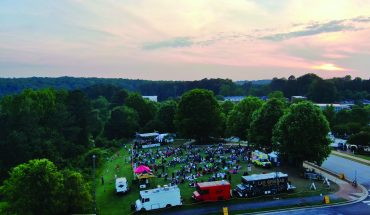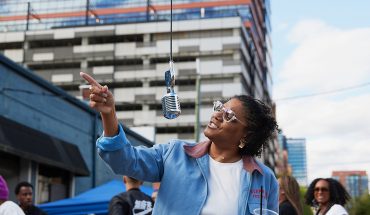by Dana Wynne Lindquist
In 1989, while I was working for a domestic violence agency, I stepped inside my great-great grandparents’ historic home for the first time.
The Victorian Italianate Merrimon-Wynne house was serving then as the office of the North Carolina Council on Women, as it had since 1975. I was a young, idealistic director of development delivering a grant application to the council. Walking up on the front porch, I felt rather proud to see my family’s name affixed to the building, especially since folks inside this architectural gem were busy addressing the needs of North Carolina women.
When I stepped into the foyer, however, my heart sank. On that particular gray March morning, the radiators hissed heat into rooms lit by low-hanging fluorescent lights. Crowded workspaces and ugly metal file cabinets made it difficult to imagine an earlier elegance. Walls painted an institutional cream needed repair. Here are the wheels of power at work, I thought, administering state funds and developing critical programs. Of course it did not need to be pretty.
I stepped back out into the cool air. The house – despite its position on the crest of a small hill, and the strong vertical lines of its many floor-to-ceiling windows – seemed dwarfed by the towering state buildings on the opposite side of Wilmington Street. My parents and grandparents had told me how the street had once been lined with spectacular Victorian residences. Many had not survived the development of a huge government complex; others had been moved out of the way of progress.
As much as I admired the seriousness of its new purpose, I felt sad that the house’s original setting had been so transformed, and that a family home had lost much of its grandeur.
At that point, I did not know how lucky it was that the house stood at all. I didn’t know that were it not for the state of North Carolina, the Merrimon-Wynne house – built in 1876 for Augustus Merrimon and purchased in 1899 after Merrimon’s death by my great-great grandmother, Lula Brookshire Page Wynne – would likely have been bulldozed long before my brief visit in 1989.
If not for the state, the home would never have been added to the National Register of Historic Places in 1975 or designated a Raleigh Historic Landmark in 1976. And were it not for a remarkable joint campaign in 1973 of the Peace College Foundation and the Historic Sites Commission, the house would not have been preserved at all.
I did not know that Lula had not yet married my great-great grandfather when she purchased the house, or that her deep commitment to First Presbyterian Church (while her husband remained a Methodist) would lead the couple to deed their home to Peace College in 1919. I did not know that as a result, the home became Lula B. Wynne Hall, a dormitory, or that in 1935 it served as the home of Peace College’s president and as the college chaplain’s residence in 1960. I did not know, when I first visited in 1989, that nearly 20 years later it would be moved to Blount Street to begin a new life.
Eight years after that first visit, in 1997, I took a part-time position teaching English at Peace College, which faced the Merrimon-Wynne House. I was pleased to be working with young women at the institution both my mother and my paternal grandmother had attended. My parents had recently moved to a newly renovated home near the northeast corner of Peace’s campus.
Their home brought our worlds close. And proximity should have made learning family history a cinch. But my husband and I were busy parenting our two young daughters, and I was juggling my job at Peace and another part-time position at N.C. State. I lived in a coffee-fueled whirl of preparation, grading, meeting with students, and caretaking at home.
I found the perfect outlet hitting the pavement near Peace: At midday, I left my office in Main Building for brisk walks downtown. I headed south on Blount. Various routes took me past the Governor’s Mansion or Edenton Street Methodist Church, sometimes even to Memorial Auditorium. But whatever my route, I always returned to Peace via Wilmington Street – past that little wedge of property where Merrimon-Wynne, as I now thought of “her,” sat.
I imagined her as a strong Southern matriarch, whose bosom might be sagging, but whose intellect remained sharp. She began to feel as familiar to me as my great aunts who lived only a few miles away, across from Broughton High School. Familiar, but largely unknown.
One day at work, I discovered the Lula B. Wynne Room on the second floor of Peace College’s East Building. I strained to construct how, precisely, she and I were related, and how she was connected to Peace. I didn’t remember that the B was for Brookshire, even though I had a great aunt named Lula Brookshire Wynne, an aunt named Marion Brookshire, and an older sister named Elizabeth Brookshire.
I’m sure my father had told me numerous times about Lula B. Wynne. But like many grown children, I had failed to create a mental image of a tidy family tree whose branches accurately held each person at the right level. There were three personages floating around in my crowded head, unwilling to land on appropriate branches: Annie Wynne, Grannie Wynne, and Fannie Wynne.
It took years, really, for me to find the mental space to situate these rhyming matriarchs firmly on their correct perches. Annie Wynne was the first wife of my great-great grandfather, James Stanhope Wynne, with whom he’d had six children, one of whom was Robert, my great grandfather. Annie died when she was only 49.
“Grannie Wynne” was Lula B. Wynne, James Stanhope Wynne’s second wife and my “step” great-great grandmother. And Fannie was Lula’s daughter-in-law, my great grandmother.
Already there
Turns out, as I was trying to bring Lula B. into focus, she was already in my life, not only as I passed the Merrimon-Wynne House where she had lived in from 1899 to 1919. She was also present as I vacationed in Montreat, at the Arts and Crafts style home she completed with my great-great grandfather in 1908, a year before he became mayor of Raleigh.
Apparently, Lula B. had indomitable energy for planning, building, and running homes. In 1920, she and James Stanhope Wynne completed their first Orlando residence, and began spending winters in Florida and summers in Montreat.
Once I connected all the “Grannie Wynne” stories and photos with Lula B., I knew that she was commanding, strict, and intimidating. She had once scolded her new daughter-in-law (my grandmother), for lining her shoes up neatly under the bed rather than putting them in the closet. She abhorred alcohol and cards, as did all “good” Montreat Presbyterians, and forbade them in her home. And she was, as the Victorians delicately put it, “plain.”
I’ve tried to imagine what it must have been like for Lula to twice marry widowers – and both men of influence. Because before she married my great-great grandfather, she was married to Allison Francis Page, founder of the Town of Cary, who died three years before she wed James Stanhope Wynne.
She won the respect, if not always the warmest affection, of her Wynne stepchildren. Her obituary lists them as, simply, hers. Remarkably, Lula and Stanhope still have one living grandchild in Raleigh, C.A. Dillon (whose mother, Annie Lee, was 20 years younger than her oldest sibling). At 88, Dillon remembers his Grannie Wynne fondly, but he doesn’t gloss over her austere demeanor.
I think the commanding Lula B. would heartily approve the dramatic renovation of Merrimon-Wynne recently accomplished by Jodi Heyens-Strenkowski, who bought the house and has transformed it into an elegant event venue. Heyens-Strenkowski herself – strikingly beautiful, willowy, athletic, sophisticated but warm – could not be more dissimilar from my great, great grandmother.
But Heyens-Strenkowski’s vision and execution of detail, all on a very tight time-line, remind me of the way Lula B. made things happen. Heyens-Strenkowski purchased the house last July and opened it with a ribbon-cutting celebration on Jan. 31 (See pages 120-121 for photos of the event). Today, the house is aglow with light that pours through uncurtained windows. A perfect palette of neutral paints and minimal furnishings puts the emphasis on its spectacular lines. Original tile fireplaces have been uncovered beneath layers of black paint, and its mahogany banister restored to its natural sheen. Outside, fresh landscaping nestles the house in its new site at the corner of Blount and Polk streets. An ample brick patio creates space for gatherings on the lawn.
Now when I walk past the Merrimon-Wynne, I can not only celebrate the new life within, I can also toast the teetotaling matriarch I feel I’ve finally come to know: Cheers, Lula B.!





